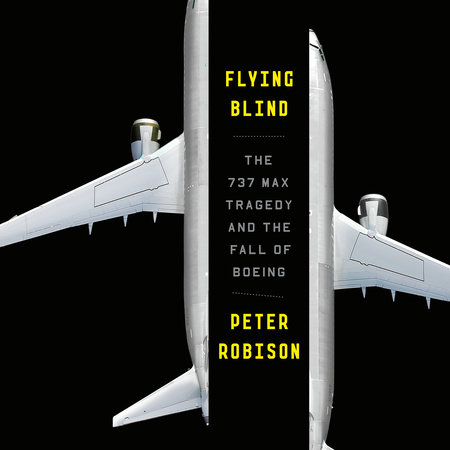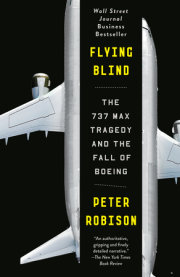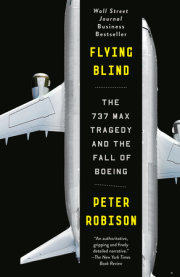CAUTION: This email originated from outside of Penguin Random House. Please be extra cautious when opening file attachments or clicking on links.
1
The Incredibles
Boeing occupies what feels like a city of its own to the south of Seattle. The company’s footprint stretches more than a mile along East Marginal Way, the comically understated name for a street where so much of consequence has taken place for a century. Today there’s a county airport known as Boeing Field; a museum that displays the original humpbacked 747; an aviation-focused high school funded by Boeing (instead of the ubiquitous 12 signs signaling support of the NFL’s Seattle Seahawks, students there hang a √144); and block-long buildings where engineers and mechanics test and develop aircraft like the MAX. One massive building, in fact, was camouflaged as a town during World War II, when Boeing churned out bombers crucial to the war effort. Fake suburban streets were built atop the roof to confuse potential aerial attackers, complete with wooden houses and trees made from wires and chicken feathers.
War was actually the reason the American company would go on to dominate the jet age that brought international travel to the masses in the decades that followed. Days after Germany’s surrender in May 1945, a Boeing engineer named George Schairer sent a letter from a forest near the town of Braunschweig. Schairer had joined a team of civilian advisers working with U.S. Army intelligence there to examine the research files of the Reichsmarschall Hermann Göring Aeronautical Research Institute. What he saw stunned him. The Germans, he realized, understood far more than anyone else about the potential of mating jet engines to swept-back wings. Most planes at the time still used propellers and perpendicular wings, jutting out from the fuselage at ninety-degree angles. Wind tunnel data that Schairer examined in the files showed a massive increase in speed and performance when wings were made to point slightly back, particularly when the engines hung beneath the wings in pods rather than being nested inside them, as had been the custom. The arrangement compensated for drag by making the wing itself more flexible in meeting wind resistance. Schairer sent seven cramped pages of mathematical formulas and sketches to a colleague in Seattle.
The timing was good; Boeing was then in the midst of a competition with three other manufacturers to build a jet-powered bomber for the U.S. Army Air Forces. The others soon got access to the same German data, but they all opted for fixed-wing designs, and Boeing won the contract for the B-47, whose mission was the rapid delivery of nuclear bombs to targets in the Soviet Union.
At $3 million apiece, the B-47 was the most expensive plane Boeing had ever built when it entered production in 1951. More importantly, the contract would give Boeing a crucial head start in technology that could serve as the basis of long-distance travel for generations to come--if the company chose to take such a gamble.
Boeing’s president, William Allen, didn’t have the appearance of a bold man of action. Before taking the top job in 1945, he’d been the company’s chief lawyer and a board member for fifteen years. He never traveled without Triscuits and two pairs of eyeglasses. The night he became president, he jotted a series of resolutions into his diary. Among the promises he made to himself, in addition to daily sit-up exercises: “Be considerate of my associates’ views”; “Don’t talk too much, let others talk”; “Make a sincere effort to understand labor’s viewpoint”; and “Develop a postwar future for Boeing.”
Douglas Aircraft, in Long Beach, California, was then the acknowledged king of the skies. Since before the war, the propeller-driven DC-3 had been the backbone of commercial airline fleets, carrying as many as thirty-two people in graceful silvery skins that reflected the age’s Art Deco aesthetic. The conditions inside were less graceful--bumpy, noisy, and, during storms, wet (the windows leaked). A cross-country flight took fifteen hours with three refueling stops. Douglas sold more than six hundred of them--trouncing a competing Boeing model eight to one--and during the war the United States ordered ten thousand copies of a military version. The California company had more of the same on its drawing boards--propeller-driven planes that were a bit larger, a bit faster, and a bit longer range.
Boeing was merely one among many airplane manufacturers in a business where gold-rush opportunity mingled with high risks. The youthful companies were controlled by dominant, strong-willed founders like Donald Douglas in Los Angeles, Glenn Martin in Baltimore, and James McDonnell in St. Louis.
Bill Boeing had been one, too. A wealthy timber heir who also owned a shipyard, he and a friend, a naval officer named Conrad Westervelt, got their first taste of flight at a 1914 Fourth of July fair on Seattle’s Lake Washington. They took turns climbing into the open cockpit of a barnstormer’s rickety seaplane, donning goggles to cruise a thousand feet over the hourglass of land between the lake and Elliott Bay. Afterward, Boeing, who’d studied engineering at Yale University, told Westervelt, also an engineer: “There isn’t much to that machine. I think we could build a better one.”
Boeing took flying lessons at Martin’s school and bought his own Martin seaplane for $10,000. Flying it over Seattle, he tossed out missile-shaped leaflets urging military preparedness as the Great War raged in Europe. With help from a pontoon builder at his shipyard and others they hired, Boeing and Westervelt assembled the B&W Model 1, a seaplane made of spruce and Irish linen. Boeing took it out himself on June 15, 1916, taxiing to the center of Seattle’s Lake Union and gunning the 125-horsepower engine. The plane skipped and threw spray before lifting into straight flight for a quarter mile. The navy transferred Westervelt back to the East Coast later that summer, but Boeing incorporated his Pacific Aero Products Company and converted part of his shipyard on the Duwamish River south of the city into its base of operations. In a wooden hangar--the famous “Red Barn” preserved in the museum near Boeing Field--some one hundred designers and carpenters worked on drafting tables and sawhorses to make an improved version of the Model 1.
The navy placed an order, the start of a rewarding relationship with the government that led to bombers and, finally, airmail contracts that were the industry’s bread and butter in those days before passenger travel was widely accepted. By 1928, almost one-third of U.S. airmail was carried by Boeing Air Transport, and the following year Boeing merged all of his interests--by then including the engine maker Pratt & Whitney and the airline United Air Lines--into a single entity called the United Aircraft and Transport Corporation.
The vertically integrated juggernaut was not to be. Airmail contracts became an early target of President Franklin Roosevelt’s new Democratic administration in 1933, and congressional investigators probed allegations of collusion in awarding them. Boeing himself was grilled for six hours by Senator Hugo Black of Alabama, later one of the longest-serving Supreme Court justices. In that miserable Depression year, with unemployment at 25 percent, Black made Boeing read out the profits from every sale of shares he’d made and the executive salaries at each subsidiary. The senator asked about former army and navy officers who’d gone on to work at the company, even insinuating that Boeing’s friend Westervelt was responsible for its first navy contracts. His investigators dug up a copy of a Pratt & Whitney newsletter boasting of an employee who’d be serving as both a U.S. Marine Corps officer and a sales representative during a tour in U.S.-occupied Nicaragua (“We all hope he has a good trip and everyone here has put in an order for a bandit’s scalp,” the item concluded cheerily.) “I do not know anything about it,” Boeing said.
The next year, Congress passed a law barring airplane manufacturers from owning airlines and required a rebid of all existing contracts. Bill Boeing, at fifty-three, took early retirement and, in disgust, sold all of his shares in the newly separated companies. He spent his later years raising Hereford and Angus cattle on a five-hundred-acre farm, sailing on his yacht, Taconite, and smartly investing his tidy fortune as a silent partner in housing subdivisions around Seattle. (As was common at the time, his developments in such north-end neighborhoods as Blue Ridge and Richmond Beach attached racially restrictive covenants to the property deeds that barred nonwhite people from living there unless they were domestic servants.)
Now Boeing was former chief counsel William Allen’s company. The safe bet would have been to milk the military business. It had roared back to life during the war, when Boeing was making more than a dozen B-17 Flying Fortress bombers in a single day, and fears of a descending Iron Curtain promised continuing military expenditures.
A commercial aircraft presented vastly greater challenges, for reasons still true today. Most obviously, there’s no government contract putting a floor under revenue for passenger planes, promising a certain return if milestones are met. For a commercial plane, the capital to turn a blueprint into reality--the massive sums for machinery, tools, engineers, mechanics, pilots, flight testing, marketing, administration, regulatory affairs, customer service--all comes up front. After years of expense the manufacturer has a single product, with no guarantee of sales. A plane maker’s customers--commercial airlines--are often reluctant to commit until they see the finished item, so projects must be launched with a handful of buyers attached, in the hope that more join later. Diligent market research only goes so far. It takes intuition, judgment, and ultimately, an iron gut.
British plane maker De Havilland thought it had the right combination. The maker of a celebrated World War II propeller-driven bomber called the Mosquito, De Havilland was already building the world’s first commercial jetliner when Boeing was considering its own entry. Allen and his deputies took a close look at the British plane, called the Comet, during the 1950 Farnborough Air Show, just outside London. They concluded it wasn’t ambitious enough, carrying just thirty-six passengers. The design Boeing would be implementing called for one hundred seats, which would allow it to generate more revenue--though some at Boeing argued the public would never stomach so many fatalities at once in the event of an accident.
Boeing had an advantage that its British competitor from a fading empire didn’t: the financial support of the new colossus of the free world. Beyond commercial flight, the Boeing entry could be used by the U.S. Air Force as a jet-powered tanker. So in April 1952, Boeing’s board agreed to invest $15 million--an amount four times greater than its total profits over the previous seven years--in a dual-purpose prototype. The marketing department already had the Boeing 707 in mind as a name; it sounded lucky. For the time being the model was known by a comparatively unmemorable moniker, the 367-80, Dash 80 for short.
Ten days after the board’s approval, a Comet operated by the British flag carrier BOAC completed its first revenue flight from London to Johannesburg, with stops in Rome, Beirut, Khartoum, Entebbe, and Livingstone, in just under twenty-four hours--almost 50 percent faster than the typical forty-hour journey. This exciting new way of travel got a powerful endorsement from Britain’s Queen Mother and her glamorous daughter, Princess Margaret, who flew in a “Royal Comet” to Rhodesia the following year.
The dazzlement soon faded. One of the elegant-looking planes ran off a runway in Rome, and two others crashed soon after takeoff, killing fifty-four people. De Havilland had to redesign the leading edges of its wings (which hadn’t benefited from German expertise: the engines were still embedded in them). Then, in 1954, two Comets went down at sea within three months of each other, causing another fifty-six deaths. After pieces of the aircraft were recovered, investigators determined they had simply broken apart. The designers hadn’t accounted for the way metal expands and contracts with extreme temperature changes. Over repeated flights the skin had weakened, especially around the Comet’s square windows, and the result was an explosive decompression. De Havilland made improvements, but commercial prospects for the Comet were finished. Jet travel was so compelling--effectively shrinking the world in half--and so much more comfortable than what came before it that people were willing to stomach some risk. But not if flying in jets looked like a death warrant. The stakes for Boeing had risen.
With years of B-47 flights behind them, its engineers had already chosen round windows and a thicker skin for its first jet-powered commercial aircraft. They welded pieces of titanium known as “tear stoppers” into the fuselage to prevent any tiny cracks from spreading.
1. The Incredibles
13 One massive building: Colin Diltz, “Boeing Made an Entire Fake Neighborhood to Hide Its Bombers from Potential WWII Airstrikes,” Seattle Times, June 9, 2016.
13 Days after Germany’s: The description of how Boeing made use of Nazi aeronautical research comes from Robert J. Serling, Legend and Legacy: The Story of Boeing and Its People, 84, and Eugene Rodgers, Flying High: The Story of Boeing and the Rise of the Jetliner Industry, 99.
14 At $3 million apiece: Serling, 95.
14 He never traveled: Serling, 251.
14 “Be considerate of”: Rodgers, Flying High, 78.
15 The conditions inside: Joe Sutter, 747: Creating the World’s First Jumbo Jet and Other Adventures from a Life in Aviation, 26.
15 “There isn’t much”: Harold Mansfield, Vision: A Saga of the Sky, 10.
15 Flying it over Seattle: Mansfield, 13.
15 Boeing took it out himself: Walt Crowley, “Boeing-Built Airplane, the B&W, Makes Its Maiden Flight from Seattle’s Lake Union on June 15, 1916,” HistoryLink.org, November 23, 1998.
16 By 1928, almost one-third: Rodgers, Flying High, 43.
16 Boeing himself was grilled: The transcript of the hearing appears in Investigation of Air Mail and Ocean Mail Contracts, Hearings Before a Special Committee on Investigation, United States Senate, U.S. Government Printing Office, 1934.
17 As was common: The text of the racially restrictive covenants attached to property deeds in Boeing developments from 1935 to 1944 read, “No property in said addition shall at any time be sold, conveyed, rented, or leased in whole or in part to any person or persons not of the White or Caucasian race. No person other than one of the White or Caucasian race shall be permitted to occupy any property in said addition of portion thereof or building thereon except a domestic servant actually employed by a person of the White or Caucasian race where the latter is an occupant of such property.” Catherine Silva, The Seattle Civil Rights & Labor History Project, University of Washington, https://depts.washington.edu.
17 Allen and his deputies: Serling, Legend and Legacy, 123.
18 So in April 1952: Eugene E. Bauer, Boeing: The First Century, 138.
18 Ten days after the board’s: A. M. “Tex” Johnston, Tex Johnston: Jet-Age Test Pilot, 172.
18 This exciting new way: British Movietone, “Queen Mother and Princess Home from Rhodesia--1953,” https://www.youtube.com/watch?v=rWMql0FA4XY.
18 One of the elegant-looking: Robert G. Pushkar, “Comet’s Tale: A Half Century Ago, the First Jet Airliner Delighted Passengers with Swift, Smooth Flights Until a Fatal Structural Flaw Doomed Its Glory,” Smithsonian, June 2002.
18 Then, in 1954: Pushkar.
19 He got his nickname: Johnston, Tex Johnston, 1.
Disclaimer - Berryville Graphics, Inc.
The information contained in this communication from the sender is confidential. It is intended solely for use by the recipient and others authorized to receive it. If you are not the recipient, you are hereby notified that any disclosure, copying, distribution or taking action in relation of the contents of this information is strictly prohibited and may be unlawful.
This email has been scanned for viruses and malware, and may have been automatically archived by Mimecast Ltd, an innovator in Software as a Service (SaaS) for business. Providing a safer and more useful place for your human generated data. Specializing in; Security, archiving and compliance. To find out more Click Here.
Copyright © 2021 by Peter Robison. All rights reserved. No part of this excerpt may be reproduced or reprinted without permission in writing from the publisher.










